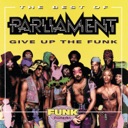Funk
George Clinton & Parliament Funkadelic performing at Waterfront Park in Louisville, Kentucky, 2008
Photograph by JM SchneidKey Attributes of Funk
Select to filter timelineThemes
- Civil Rights
- Political Issues/Activism
- Black Power/Pride
- Daily Life
- Nightlife/Parties
- Social Consciousness
- Segregation
Musical Features
- Vocals
- Instrumentals
- Blues Form
- Electronic Sounds
- Timbre
- Polyrhythms
- Syncopation
- Vocal Sounds
- Repetition
- Groove
- Riffs
Instruments
- Bass
- Drums
- Electric Piano/Synthesizer
- Horn
- Organ
- Other Electronic Instruments
- Other Percussion
- Piano
- Woodwinds
“Funk is the means by which Black folks confirm identity through rhythm, dance, bodily fluids, and attitude. Funkiness in a person’s behavior or attitude can mean anything from an ego trip, to a protest, to escapism.”Rickey VincentAuthor/Radio Host
Funk is an instrumental and vocal genre of dance music popularized in the 1970s that embraces many styles from the jazz, blues, rhythm and blues, soul jazz, gospel, and rock traditions. Rhythm takes precedence over melody and harmony, and repetitive “grooves” keep the dancers moving. Funk came on the scene during a period of social activism in the late 1960s and crystallized during the 1970s.
Context and History
Funk music, labeled “happy music” by drummer Hamilton Bohannon, reunited African Americans “one nation under a groove.” Its emergence parallels the transition from a segregated to a “desegregated” post–civil rights society in the late 1960s and early-1970s. Despite promises for new opportunities and advancement, the Black working class and the poor experienced little change in their lives in an era of deindustrialization and during two recessions 1973–1975 and 1980–1982. At the same time, members of the Black middle class encountered exclusionary practices in integrated workplaces, housing, and social settings. The prospect for advancement in corporate America, and predominantly white institutions of higher education, became illusive for many. The term “funk” as well as the diversity of funk music’s styles captures both the complex, and often contradictory, feelings of optimism, ambivalence, disillusionment, and despair that accompanied the transition from a segregated to a post–civil rights society.
Among the pioneers of funk are James Brown and Sly and the Family Stone, whose revolutionary sounds became popular at the height of the Black Power, anti–Vietnam War and hippie movements of the late 1960s. Soul singer James Brown gave funk its polyrhythmic foundation, onto which Larry Graham, Sly Stone’s bass player, added a percussive bass guitar style as heard in “I Want to Take You Higher” (1968). Sly Stone introduced rock technology (wah-wah pedal, fuzz box, echo chambers, vocal distortion, etc.) and a blues-rock-flavored guitar in his music (“Don’t Call Me Nigger, Whitey” 1969) (explicit).
Although a core set of features define the funk tradition, it is stylistically diverse, influenced by various factors: regional preferences, musical background of performers, and new technologies. The J.B.s (James Brown’s backup band) (“Maceo” 1970), Kool and the Gang (“Love the Life You Live, Pts. 1 & 2” 1971), the Ohio Players “Pain” (1972), and Earth, Wind & Fire (“Shining Star” 1975) represent a jazz-derived funk style that incorporates solos, horn riffs, and melodic phrasings from the bebop and swing band tradition. The sound of funk groups from Dayton, Ohio (Slave “Slide” 1977 and Lakeside “Fantastic Voyage” 1980), California (Con Fun Shun “Ffun” 1977), and the South, especially Memphis (Bar-Kays), reflect their roots in rhythm and blues, whose rhythmic patterns and horn arrangements are best illustrated by the Bar-Kays’ “Shake Your Rump to the Funk” (1976). Funk musicians who “apprenticed” in the Black church often reveal a gospel influence in their sound, such as the Isley Brothers, a former gospel quartet (“Freedom” 1970). Larry Graham, Sly Stone’s former bass player and leader of Graham Central Station, incorporates the vocal stylings, percussive timbres, and “shout” rhythms of the Black Pentecostal and Sanctified churches, as heard in “Release Yourself” (1974).
One of the most innovative funk styles that became associated with Parliament-Funkadelic, the Parlets and the Brides of Funkenstein was the brainchild of George Clinton. Known as P-funk and described as pure funk, it builds on the musical foundation established by James Brown and Sly Stone and is rooted in the ideology of Black Power. Clinton observed that the movement towards a desegregated society resulted in the erosion of Black cultural values and the fragmentation of Black communities. He believed that Black people should liberate themselves from the social and cultural restrictions of society, a philosophy. Towards this end, he encouraged them to culturally redefine themselves in the land of funk evident in Parliament’s “Mothership Connection (Star Child)” (1975) and “Flashlight” (1977). P-funk has its own language, fashion, dances, and mythical heroes and villains who Clinton presents as science-fiction characters.
Although most traditional funk bands had begun to disappear from the popular soundscape by the early 1980s, Cameo was one of the few 1970s bands that successfully transitioned to the synthesized-funk aesthetic (labeled techo-funk) and preserved the 1970s funk sensibility heard in “Word Up” (1986) and “Skin, I’m In” (1988). The traditional funk aesthetic, however, has been preserved in the samples of countless hip-hop tracks and in many R&B tracks.
Musical Features/Performance Style
Funk musicians primarily use electronic instrumentation such as electric guitars and basses, synthesizers and organs; horns and additional percussion instruments might also be present. Bass guitar functions as a melodic instrument played in a percussive style. Funk’s musical core relies on a steady drumbeat. This repetitive, syncopated, and polyrhythmic “groove,” established by the bass guitarist and drummer, serves as the foundation for layers of different rhythmic patterns generated by the horn and rhythm sections. The rock aesthetic introduced by Sly Stone became a distinguishing component of P-funk. Clinton exploited the use of synthesizers and other technologies in “Flashlight” (Parliament, 1978).
In the mid-1970s, disco rhythms infiltrated the funk groove and group-oriented singing gave way to lead vocals by the end of the decade. Synthesizers and computers had begun replacing or were used in conjunction with horn and bass players and, in some cases, drummers. This hybrid disco-funk style is heard in Con Funk Shun’s “Chase Me” (1978), Heatwave’s “The Groove Line” (1978), and Dayton’s “Hot Fun in the Summertime” (1982), originally recorded by Sly and the Family Stone. Zapp and Roger borrowed from the high-tech P-Funk aesthetic to produce strong dance rhythms and varied vocal and instrumental timbres. Roger Troutman also experimented with the talk box (also known as the voice box) heard in “More Bounce to the Ounce” (1980).
Lyrics
Funk lyrics cover a broad range of themes. Recurrent chanted phrases like “party,” “dance, dance all night,” “let yourself go,” and “give up the funk” encourage dancers to escape temporarily from the uncertainties and pressures of daily life. Kool and the Gang (“Funky Stuff,” 1973), the Bar-Kays, the Gap Band, and Roger popularized funk as party music. Albums such as Sly and the Family Stone’s Stand! (1969), Earth, Wind and Fire’s That’s the Way of the World (“That’s the Way of the World,” 1975) and Kool and the Gang’s Spirit of the Boogie (1975) address issues including society’s need to care for its children, peace on earth, universal understanding, love, and fulfilling relationships. Socio-political commentary, rooted in the ideology of Black Power, forms the core theme of P-funk, whose song lyrics encourage Black people to celebrate their “Blackness” by creating new spaces for social interaction. These spaces, traditionally reserved for whites, include the White House (“Chocolate City,” 1975), outer space (“Mothership Connection,” 1975), and underwater (“Aqua Boogie,” 1978). George Clinton uses humor to address social issues, developing story lines around mythical heroes and villains presented as science-fiction characters, as in the album Clones of Dr. Funkenstein (1976). Humor also inspired the creation of Black slang from which Clinton derives song titles such as “Groovallegiance,” “Funkentelechy,” and “Prosifunkstication.” Funk ballads, as well as uptempo songs, describe the trials and tribulations of romantic encounters: Bar-Kays’ “Too Hot to Trot” (1976) and “Hit and Run” (1981); the Gap Band’s “You Dropped a Bomb on Me” (1982) and Cameo’s “Back and Forth” (1987).
Bibliography
- Maultsby, Portia K. “Funk” in Burnim, Mellonee V. and Portia K. Maultsby, eds 2nd edition. African American Music: An Introduction. 2nd ed. New York: Routledge Press, 2015, p. 301-319.
- Vincent, Rickey. Funk: The Music, The People, and The Rhythm of The One. New York: St. Martin’s Griffin, 1996.















